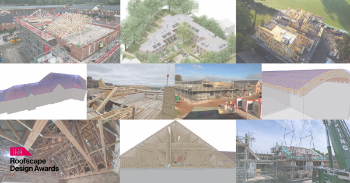Clunch

|
| The Orwell Clunch Pit, near Cambridge, is a medieval quarry that was designated a Site of Special Scientific Interest (SSSI) in 1985. |
[edit] Introduction
Clunch is a form of soft, chalky limestone rock that closely resembles chalk and shares many of its characteristics, but with lower density. It is used mainly in eastern England and Normandy.
The term is also generically applied to soft, inferior building stone that is used in place of stronger, more desirable material.
[edit] Characteristics
In its freshly quarried state, clunch is soft and holds water, which makes it easier to cut. Once dry, it hardens and becomes more difficult to cut.
Clunch was used extensively in medieval times as a building material. It was often used for chimneys, property boundary walls and small agricultural buildings.
It was not suitable for large scale use, since it would easily erode when exposed to chemicals or severe weather. Structures made from clunch had to be protected with paint, cement or stucco and could then be finished with a lime wash.
However, even when the surfaces were covered, clunch was not especially durable and could even be damaged by frost. Despite this, it was often used in certain parts of the country, since it was inexpensive and widely available.
[edit] Related articles on Designing Buildings Wiki
Featured articles and news
Moisture, fire safety and emerging trends in living walls
How wet is your wall?
Current policy explained and newly published consultation by the UK and Welsh Governments.
British architecture 1919–39. Book review.
Conservation of listed prefabs in Moseley.
Energy industry calls for urgent reform.
Heritage staff wellbeing at work survey.
A five minute introduction.
50th Golden anniversary ECA Edmundson apprentice award
Showcasing the very best electrotechnical and engineering services for half a century.
Welsh government consults on HRBs and reg changes
Seeking feedback on a new regulatory regime and a broad range of issues.
CIOB Client Guide (2nd edition) March 2025
Free download covering statutory dutyholder roles under the Building Safety Act and much more.
AI and automation in 3D modelling and spatial design
Can almost half of design development tasks be automated?
Minister quizzed, as responsibility transfers to MHCLG and BSR publishes new building control guidance.
UK environmental regulations reform 2025
Amid wider new approaches to ensure regulators and regulation support growth.
The maintenance challenge of tenements.
BSRIA Statutory Compliance Inspection Checklist
BG80/2025 now significantly updated to include requirements related to important changes in legislation.
Shortlist for the 2025 Roofscape Design Awards
Talent and innovation showcase announcement from the trussed rafter industry.























